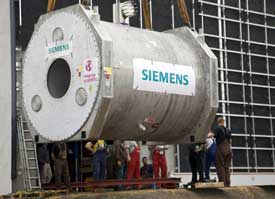Jun 6 2008
The world's largest magnet for imaging in brain research arrived today at the Jülich Research Center. Once installed, it will have a field strength of 9.4 Tesla (T), which is almost 200,000 times the strength of the Earth's magnetic field. Brain researchers at Jülich plan to use the new system, nicknamed "9point4," to visualize previously inaccessible structures and metabolic processes of the brain.

The magnet is the heart of a unique system, which will be set up in cooperation with Siemens. The system is expected to become operational in 2009, and will, for the first time, combine magnetic resonance imaging (MRI) at a field strength of 9.4 Tesla with positron emission tomography (PET). Simultaneous imaging with both devices will allow researchers to map the structures and metabolic processes of the brain in more detail than ever before – in order to study the mechanisms associated with neurodegenerative diseases, such as Alzheimer's and Parkinson's disease. "More precise insights into pathological changes of the brain may help us delay the actual outbreak of the disease for years," explained Prof. Jon Shah, manager of the Jülich-based Magnetic Resonance Physics research team. "The potential savings for the healthcare system are enormous." Siemens and the German Federal Ministry for Education and Research (BMBF) have provided funding of 10 million Euros each for the project.
The Chairman of the Management Board, Prof. Bachem, expressed his appreciation to both partners: "We are extremely pleased about the generous support of the Ministry for this pioneering project to address one of the greatest challenges our society is facing in decoding the cause of neurodegenerative diseases, and about this opportunity to demonstrate, jointly with our long-standing partner, Siemens, how to transfer basic research to practical applications with beneficial results."
"Siemens and the Jülich Research Center are strategic partners in a number of research activities that focus on energy and health. The 9.4 Tesla project is an excellent example of combining the outstanding expertise of Jülich with the technological strengths of the integrated Siemens for maximum patient benefit," commented Dr. Michael Kassner, Regional Head North Rhine of Siemens AG.
The superconducting magnet, which is about four meters long and weighs 57 metric tons, came to Jülich by heavy-load delivery from Oxford, England. It was unloaded by crane during the course of the day and placed in a new building, which had been specifically constructed to house it. Approximately 870 tons of steel provide shielding for the magnetic field to the outside in a room of approximately 150 square meters to ensure that the magnet can take up operations in the weeks to come without any hazard. Once the device is completely installed, it will have the only bore in existence with a diameter of 90 centimeters. "This will provide us with enough space to give study subjects specific tasks that require pressing buttons or moving a joystick to observe their brain functions in digital images," explained Prof. Shah.
The new 9.4-Tesla MRI represents a giant leap from 1.5T or 3T systems that are typically available in clinical settings. A higher the magnetic field equals a better signal-to-noise ratio, which makes it easier to distinguish various types of tissue. The system will allow for tracking the behavior of individual cells in live organisms, which are marked with the help of contrast medium.
The combination, with a PET insert for head imaging - which is also projected to be installed in 2009 - makes the new device truly unique. It allows for monitoring metabolic processes and makes it feasible to study sequences occurring at receptors, which are responsible for the communication between brain cells. PET images are relatively unfocused on their own and yield very vague spatial information. However, the combination of MRI and PET makes a perfect team that can supply scientists with anatomically detailed images and allow for the analysis of the ongoing molecular mechanisms at the same time. The simultaneous examination would make it feasible to study the brain from various perspectives in the same state, which would be impossible if the MRI and PET images were to be taken in sequence.
The expertise of the Jülich team in imaging techniques is boosted by its close cooperation with the industry and the nearby university clinics, especially the RWTH Aachen clinic in the JARA Brain Group. This ensures that the basic research from Jülich quickly finds practical applications, which translates into a dramatic shortening of the path from scientific insight to patient benefit.
Siemens currently is the leading provider of high-field magnetic resonance imaging, and is the world's only manufacturer to combine magnetic resonance imaging (MRI) with a field strength of 9.4 Tesla with positron emission tomography (PET). More than half of the approximately 30 systems in the 7 Tesla range currently installed around the world are Siemens systems.